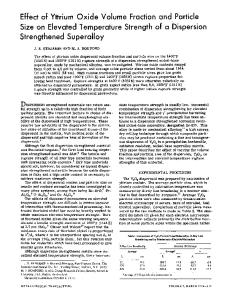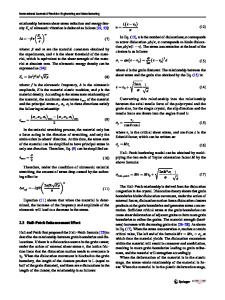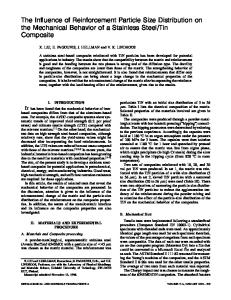The effect of particle size and volume fraction on the aging behavior of a liquid-phase sintered SiC/aluminum composite
- PDF / 2,675,921 Bytes
- 9 Pages / 598 x 778 pts Page_size
- 69 Downloads / 340 Views
I.
INTRODUCTION
IT has been well established that the addition of discontinuous ceramic particles or whiskers to aluminum matrices results in the composites exhibiting different aging kinetics compared to the unreinforced alloys. An acceleration in the aging kinetics of the composite materials has been frequently observed, t1-13] The accelerated aging was attributed to an increased dislocation density in the vicinity of the ceramic reinforcement, which hastens the nucleation and/or growth of the age-hardening precipitates. The increased dislocation density results from the differential thermal contraction between the particle and matrix produced on quenching the composite from the solutionizing step of the heat treatment (e.g., Reference 14). However, it has also been shown that the initial stages of the precipitation sequence, i.e., the formation of Guinier-Preston (GP) zones, can be suppressed by ceramic additions, vS] This alteration in the precipitation sequence is believed to result from a reduction in retained vacancies on quenching from the solutionizing temperature due to the annihilation of the vacancies, as has been discussed by Friend et al. [13] Several models have been developed to estimate the dislocation generation due to thermal expansion mismatchy6,~7]Arsenault and Shi [16] have proposed a model in which prismatic punching of dislocations occurs in the vicinity of the ceramic reinforcement. From their analysis, the total dislocation density, p, due to prismatic punching can be written: p =
BVse 1 b(1 - ~-) t
[1]
where B is a geometric constant varying between 4 and 12
G.M. JANOWSKI, formerly Graduate Student, Department of Metallurgical and Materials Engineering, Michigan Technological University, is Assistant Professor, Department of Materials Science and Engineering, University of Alabama at Birmingham, Birmingham, AL 35294-4461. BJ. PLETKA, Professor, is with the Department of Metallurgical and Materials Engineering, Michigan Technological University, Houghton, MI 49931. Manuscript submitted January 31, 1991. METALLURGICALAND MATERIALSTRANSACTIONSA
depending upon particle shape, Vyis the volume fraction of particles, e is the misfit strain from the difference in thermal expansion coefficients, b is the magnitude of the Burgers vector, and t represents the smallest dimension of the particle. From Eq. [1], higher dislocation densities are predicted to result from smaller particle sizes and larger particle volume fractions. Equation [1] also suggests that different combinations of particle sizes and volume fractions can lead to the same dislocation density. Calculations of the particle volume fractions required to attain identical dislocation densities based on Eq. [1] are shown in Table I. It was assumed that the particles were spherical, and t in Eq. [1] was equated to the particle diameter. The calculations were performed for particle size (diameter) ratios of 2, 3, and 5. As the particle size ratio increases, greater volume fractions are required in order to achieve the same dislocation
Data Loading...










